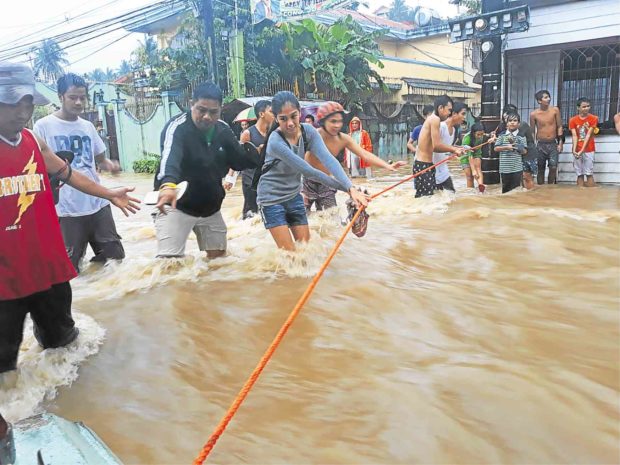
LIFELINE Residents of Old Albay District in Legazpi City use a rope to avoid being swept away by strong current as they cross a flooded street. —REY ANTHONY OSTRIA
LEGAZPI CITY—Residents of this Albay provincial capital were dismayed over the failure of a newly built flood control system to stop the knee-to-neck-deep floods that hit the business center and several low-lying villages following heavy rains spawned by the tail end of the cold front.
The three pumping stations were designed to solve the perennial flooding in Legazpi during typhoons and intense rainfall. The project, worth P2.1 billion, was funded by the national government and implemented by the Department of Public Works and Highways (DPWH).
But Mayor Noel Rosal, in an interview, said it would be unfair to blame the new project for the flooding that hit the city.
“We have yet to put this flood control structure to test,” he said.
Rosal said siltation in the city’s river channels and clogged drainage canals due to improper waste disposal by households were the main culprits for the flooding that hit 15 of 70 villages on Wednesday.
Hundreds of residents, students and workers waded through flooded streets as they waited for hours for vehicles to take them home on Wednesday night.
“I walked through waist-deep floodwater for almost three hours just to get a ride in going home to Guinobatan town,” said Jeane Recuenco, 37, who works in a telecommunications company.
Many were seen huddled around shopping malls and other establishments to wait for floodwaters to subside.
“[The] floods caught us by surprise,” said local artist Apo Gonzales, whose art collection was damaged by the floods.
Rev. Fr. Rex Arjona, Social Action Center director of the Diocese of Legazpi, said 83 people sought shelter in local churches on Wednesday.
Lucy Castañeda, spokesperson for the DPWH in Bicol, said the pumping station was “operational.”
The DPWH said the three pumping stations needed between 1.3 and 1.8 cubic meters of water elevation to start operating. Water elevation following Wednesday’s floods reached only 0.4 cubic meter.
Quoting a report from the pump station, Castañeda said: “The much needed [volume of] floodwaters did not reach the pump floodgates.”
Rosal, in a meeting with DPWH engineers, ordered the dredging of the three major river channels of Tibo, Roran and Makabalo to ease flooding in the city.
He said these water channels were becoming narrower due to siltation. Its banks, he said, had been occupied by illegal settlers.
Rosal said the city also needed to clear and declog at least three flood chokepoints and redesign dikes.
Cedric Daep, chief of the Albay Public Safety Emergency Management Office, said Wednesday’s rainfall volume was 220 millimeters, which was half of the 467 mm of rain dumped by Supertyphoon “Reming” in 2006.